A quadratic has 3 different forms, and we can switch between all of them (with a little algebra, of course!) The vertex form of a quadratic is helpful for several reasons, so it helps to know what it is and what it tells you.
So, what is quadratic vertex form? A function in quadratic vertex form looks like this: f(x) = a(x – h)2 + k, where a is not zero and (h, k) is the vertex of the function. This form tells us how high above/below the x-axis the vertex lies (the value of k) and how far left/right of the y-axis the vertex lies (the value of h).
Of course, once you are comfortable with the quadratic vertex form, it will be much easier to work with it, graph from it, and convert it to other forms.
In this article, we’ll talk about what quadratic vertex form is and what it looks like. We’ll also look at some examples and answer some common questions about this form.
Let’s get started.
What Is Quadratic Vertex Form?
Quadratic vertex form looks like this:
- f(x) = a(x – h)2 + k
where a is not zero, and (h, k) is the vertex of the parabola.
Note that the a in the quadratic vertex form is the same one as in standard form of a quadratic:
- f(x) = ax2 + bx + c
whereas b = -2ah and c = ah2 + k.
(You can get a refresher on quadratic functions and the 3 forms in my article here).
Quadratic vertex form is useful for several reasons:
- It is possible to find the zeros of the function from this form with some algebra (by solving the equation for x with f(x) = 0)
- It is easy to find the vertex of the corresponding parabola (we just read the values of h and k to get the coordinates (h, k) for the vertex)
- It is easy to find points to start graphing the corresponding parabola (use the vertex (h, k) as a base, and use the zeros if the function has them, or choose x = 0, f(x) = f(0) = ah2 + k).
Let’s take a look at some examples to show how to do all of these things (finding the zeros, finding the vertex, and graphing the parabola).
How To Find The Zeros Of A Quadratic Function In Vertex Form
To find the zeros of a quadratic function in vertex form, we need to solve for f(x) = 0. So, we need to find the x values that give us a(x – h)2 + k = 0.
Solving for x, we get:
- a(x – h)2 + k = 0
- a(x – h)2 = -k
- (x – h)2 = -k/a
- (x – h) = +/- √(-k/a) [take the positive and negative square roots]
- x = h +/- √(-k/a)
So, we get two zeros for the quadratic function: x = h + √(-k/a) and x = h – √(-k/a).
Note that there are three separate cases for the zeros:
- If k = 0, we get one repeated real root, x = h.
- If a and k have opposite signs, then –k/a is positive and we get two distinct real roots.
- If a and k have the same signs, then –k/a is negative and we get two complex conjugate roots.
These zeros tell us that f(h + √(-k/a)) = 0 and f(h – √(-k/a)) = 0. This information is helpful when graphing the corresponding parabola.
Let’s look at some examples to make sure the concept is clear.
Example 1: Finding The Zeros Of A Quadratic Function In Vertex Form
Let’s say our quadratic function in vertex form is:
- f(x) = 2(x – 3)2 – 18
Here, we can see that a = 2, h = 3, and k = -18, which means the vertex of the parabola is at (h, k) = (3, -18).
Also, the zeros of the function are:
- x = h + √(-k/a) and x = h – √(-k/a)
- x = 3 + √(-(-18)/2) and x = 3 – √(-(-18)/2)
- x = 3 + √(9) and x = 3 – √(9)
- x = 3 + 3 and x = 3 – 3
- x = 6 and 0
So f(6) = 0 and f(0) = 0. As a quick check, we can take the average of the x-coordinates of the zeros to get (6 + 0)/2 = 3, which is the same as the x-coordinate of the vertex.
You can see the graph of the quadratic function f(x) = 2(x – 3)2 – 18 below.
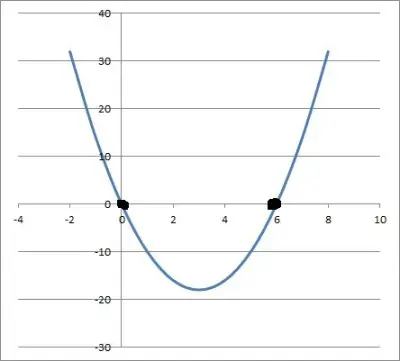
Example 2: Finding The Zeros Of A Quadratic Function In Vertex Form
Let’s say our quadratic function in vertex form is:
- f(x) = 3(x – 1)2 + 12
Here, we can see that a = 3, h = 1, and k = 12, which means the vertex of the parabola is at (h, k) = (1, 12).
Also, the zeros of the function are:
- x = h + √(-k/a) and x = h – √(-k/a)
- x = 1 + √(-12/3) and x = 1 – √(-12/3)
- x = 1 + √(-4) and x = 1 – √(-4)
- x = 1 + 2i and x = 1 – 2i
So f(1 + 2i) = 0 and f(1 – 2i) = 0 (note that these are both complex numbers). As a quick check, we can take the average of the x-coordinates of the zeros to get ((1 + 2i) + (1 – 2i))/2 = 1, which is the same as the x-coordinate of the vertex.
You can see the graph of the quadratic function f(x) = 3(x – 1)2 + 12 below (note that the zeros do not appear on the graph, since they are not real values).
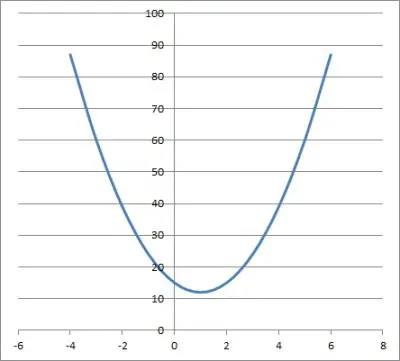
How To Find The Vertex Of A Quadratic Function In Vertex Form
To find the vertex of a quadratic function in vertex form, we read the values of h and k in the equation and use them to write the vertex as (h, k).
Example 1: Finding The Vertex Of A Quadratic Function In Vertex Form
Let’s go back to the quadratic function in vertex form from the first example above:
- f(x) = 2(x – 3)2 – 18
Here, we can see that a = 2, h = 3, and k = -18, which means the vertex of the parabola is at (h, k) = (3, -18).
That is all the work we need to do to find the vertex!
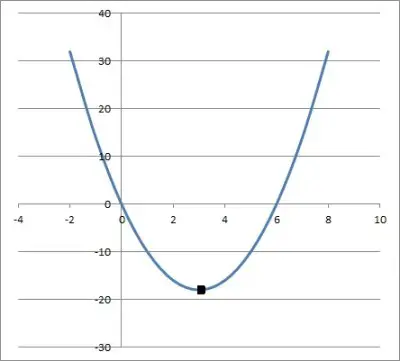
Example 2: Finding The Vertex Of A Quadratic Function In Vertex Form
Let’s go back to the quadratic function in vertex form from the first example above:
- f(x) = 3(x – 1)2 + 12
Here, we can see that a = 3, h = 1, and k = 12, which means the vertex of the parabola is at (h, k) = (1, 12).
That is all the work we need to do to find the vertex!
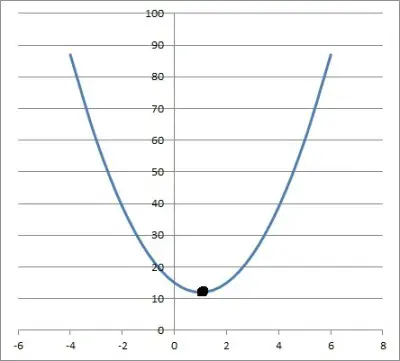
How To Graph Using Vertex Form
The best way to graph using quadratic vertex form is to start by plotting a few key points:
- First, plot the vertex (h, k), which you can easily find from the equation with the values of h and k.
- Next, substitute x = h + 1 into the quadratic equation to get f(h + 1) = a + k, giving you the point (h + 1, a + k) to plot.
- Finally, substitute x = h – 1 into the quadratic equation to get f(h – 1) = a + k, giving you the point (h – 1, a + k) to plot.
After plotting the 3 key points, fill in the sketch in the shape of a parabola so that it goes through the 3 points.
Let’s take a look at some examples to see how this works in practice.
Example 1: Drawing A Graph Using Vertex Form
Once again, consider the quadratic function in vertex for from earlier examples:
- f(x) = 2(x – 3)2 – 18
Here, we can see that a = 2, h = 3, and k = -18, which means the vertex of the parabola is at (h, k) = (3, -18), and this is the first point we will graph.
We also know that if x = h + 1, then y = a + k, so the point (h + 1, a + k) = (4, -16) will be on the graph.
Finally, we know that if x = h – 1, then y = a + k, so the point (h – 1, a + k) = (2, -16) will be on the graph as well.
So, we will graph our 3 key points: (3, -18), (4, -16), and (2, -16) and sketch the graph of a parabola that goes through all 3 points:
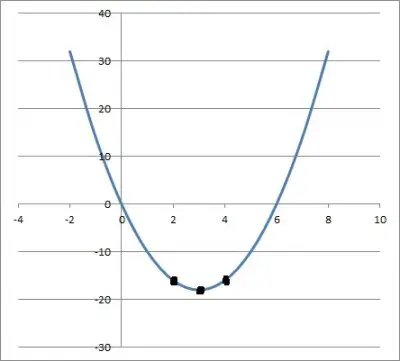
Example 2: Drawing A Graph Using Vertex Form
Once again, consider the quadratic function in vertex for from earlier examples:
- f(x) = 3(x – 1)2 + 12
Here, we can see that a = 3, h = 1, and k = 12, which means the vertex of the parabola is at (h, k) = (1, 12), and this is the first point we will graph.
We also know that if x = h + 1, then y = a + k, so the point (h + 1, a + k) = (2, 15) will be on the graph.
Finally, we know that if x = h – 1, then y = a + k, so the point (h – 1, a + k) = (0, 15) will be on the graph as well.
So, we will graph our 3 key points: (1, 12), (2, 15), and (0, 15) and sketch the graph of a parabola that goes through all 3 points:
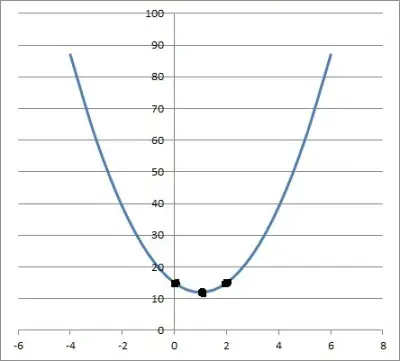
Conclusion
Now you know what quadratic vertex form is and how it can be useful for graphing the corresponding parabola by finding the zeros and vertex.
You can learn about quadratic factored form in this article.
You can learn about the quadratic formula (and when to use it) here.
You can learn about how to solve and graph quadratic inequalities in my article here, or learn more about what the solutions of a quadratic equation represent in my article here.
You can learn more about the roots and coefficients of a quadratic equation in my article here.
You might also want to read my article on when a quadratic function is negative or my article on how to change the shape of a parabola.
I hope you found this article helpful. If so, please share it with someone who can use the information.
Don’t forget to subscribe to our YouTube channel & get updates on new math videos!



